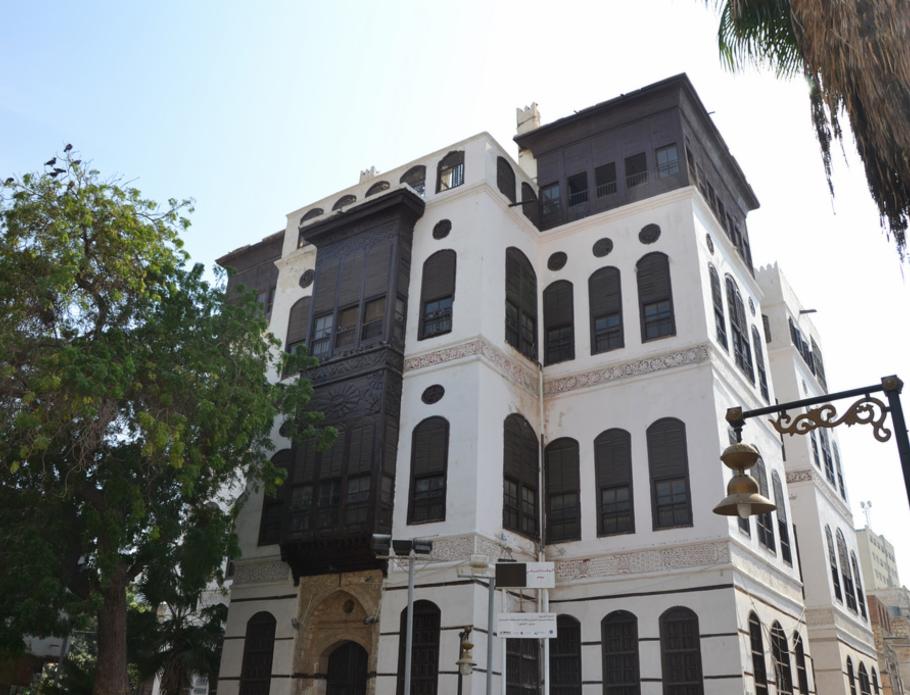Tourism officials aim to awaken Saudis to their own history with new museums, historic centers
Photo: Al Naseef House in Old Jeddah, Saudi Arabia / Sammy Six / Creative Commons
In 2004, the Naseef House in Old Jeddah, Saudi Arabia, required much-needed attention. The three-storey 19th- century home, built by the wealthy merchant Omar Afandi Naseef, served as a museum, but its exhibits were poorly presented and dusty, and the structure in desperate need of renovation.
Today, the 106-room Naseef House, featuring Ottoman-Turkish architecture with refurbished colored tiles, ornamentation, frescoes and lattice adorning the windows, is the cultural center of the Balad District in Old Jeddah. Its exhibits are protected, catalogued and handled by attendants trained in museum operations.
The Naseef House, perhaps one of the most visited historic sites in Saudi Arabia, is part of the kingdom's efforts to showcase its long and neglected history by building museums and renovating existing historic sites throughout the country.

Photo: Naseef House in Old Jeddah, Saudi Arabia / Muna al-Mahdi / Creative Commons
Even Saudi Arabia's pre-Islamic history, virtually ignored since the founding of the country in 1932, has received intense interest and protection in such rural areas as Mada'in Saleh, Al-Ula and Tem'a.
The challenge for the Saudi Commission for Tourism and National Heritage (SCTH) remains how to interest Saudis in their own history and, by extension, how to get them to view museums as family-friendly attractions.
It's likely some projects may be put on hold due to the kingdom's economic slowdown, attributed to plummeting oil prices, but many projects using private funds that are near completion still have the green light to proceed.
Prince Sultan bin Salman bin Abdulaziz, president of the SCTH, is optimistic that the agency’s projects will be complete.
“The great risk in any economy is the lost chances, considering that many chances have been missed in different areas,” said Prince Sultan in a statement. “However, things are getting better and in gradual rectification after recent and successive resolutions by the state [to] enhance the tourism and national heritage growth … have generated a stimulating environment for domestic investment.”
Yaroub H. Al-Ali, manager of archaeology at the Tabuk Antiquities office, says there is a push to build museums and generate interest among Saudis who generally do not look at visiting museums as a family activity.
NEW MUSEUMS
New museums are underway or near completion in Abha, Al-Ahsa, Dammam, Hail, Tabuk, Al-Jouf, Najran, Tem'a, the Qassim region and the Northern Borders.
"We are trying to introduce Saudis to the concept of museums and have them bring their families," says Al-Ali. "We have one already underway here in Tabuk."
The Tabuk project is an ambitious effort to tell the story of the Hejaz Railway. Construction on the railway began in 1900 and was to extend from the Ottoman Empire capital of Constantinople (present-day Istanbul) through the northern Arabian Peninsula to Tabuk and Medina on its way to Mecca to provide transportation for Hajj pilgrims. The railway abruptly ended in Medina when World War I interrupted its progress and T.E. Lawrence's forces repeatedly attacked it, a campaign memorably dramatized in the film “Lawrence of Arabia.”

Photo: Remains of the Hejaz railway, a steamtrain on the tracks for the Potash mine near Wadi Rum / Karen Melchlor / Creative Commons
Tabuk and Medina have the most comprehensive collections of Hejaz Railway artifacts with each possessing locomotives. The Medina railway museum is complete and open to the public. The Tabuk railway station in the center of the city will feature a one-storey museum set to open to the public in October 2016. The museum includes the locomotive, freight cars, railway houses, exhibits and a handicrafts center housed in a different building, accord to Al-Ali.
Perhaps the most important learning facility planned is the Makkah Museum, which will focus on the history of the Islamic faith and will bring an estimated 10 million visitors annually.
The British architectural firm Mossessian Architecture won the bid in January to design the 5,600-square-meter facility about 7 kilometers from the Grand Mosque. It will include gallery space dedicated to Islamic history, an auditorium, teaching facilities, a climate-controlled roof garden, restaurant, bookstore and reception area. The studio Adeline Rispal of Paris designed a "central void" inside the museum to act as a "virtual minaret" that visitors ascend as they stroll through each exhibition.
Despite the uncertainty of some projects, two museums focusing on the sciences remain viable. The King Abdullah Financial District (KAFD) in Riyadh will be home to a new 27,166-square-meter $32 million KAFD GeoScience Center that will be finished in 2017. Focusing on environmental education, it features a monorail system, skyways and a below-grade pedestrian walkway resembling a traditional wadi. Complementing the science center is the KAFD Aquarium that will open in 2018.
HISTORIC CENTERS
The kingdom will also see the construction of the $1.86 million Tem'a Historic Center, about 260 kilometers southeast of Tabuk, which is expected to include pre-Islamic artifacts.
In addition, the $26.6 million King Abdullah Cultural Center in Qassim, the King Abdul Aziz Center for Knowledge Enrichment in the Eastern Province with a $27 million budget and the Al-Ahsa Museum with its $7.4 million price tag have also been approved for construction.
At Al-Ahsa, parks and historical and archaeological sites will complement the museum. Al-Ula historic district, with its large number of abandoned historic residential structures, will also undergo rehabilitation.
© SalaamGateway.com 2016

Rob L. Wagner